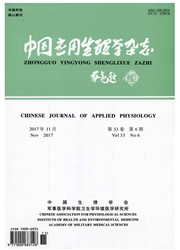

 中文摘要:
中文摘要:
目的:模拟颅脑创伤(TBI)后的化学微环境,探讨损伤组织提取液对温度敏感型脐带间充质干细胞(ts UC)增殖和分化影响。方法:用液压冲击损伤仪建立大鼠颅脑创伤模型,获取损伤区域脑组织的匀浆液,用于模拟TBI后的化学微环境。分离培养人脐带间充质干细胞(UC),通过感染携温度敏感型猿猴病毒40大T抗原(ts-SV40LT)基因的逆转录病毒,以建立ts UC系。在模拟脑组织弹性模量的聚丙烯酰胺水凝胶上进行细胞培养。实验分为UC组(37℃,加入PBS)、ts UC组(33℃,加入PBS)、UC+提取液组(37℃)、ts UC+提取液组(33℃持续3d,后转至37℃)(n=4)。动态观察各组细胞的生长情况和形态变化,24 h后检测细胞的凋亡水平,3 d检测细胞的增殖情况,7 d检测其向神经元和星形胶质细胞分化的水平。结果:与UC+提取液组相比,ts UC+提取液组的凋亡细胞和增殖率分别显著性减少和增加(P〈0.01);细胞免疫荧光结果显示,ts UC+提取液组GFAP和Neu N阳性细胞均比UC+提取液组显著性增加(P〈0.01)。结论:在模拟脑损伤的化学微环境中,温敏脐带间充质干细胞联合亚低温可显著逆转脑损伤诱导的细胞凋亡,促进细胞的增殖以及向神经细胞的分化,从体外角度证实了温敏脐带间充质干细胞在亚低温环境下对TBI后脑组织微环境的适应性和耐受性。
 英文摘要:
英文摘要:
Objective: To simulate the chemical microenvironment of injured brain tissue, and to explore the effect of this chemical mi- croenvironment on temperature sensitive un~ilical cord mesenchymal stem ceils (tsUC). Methods: Rat models of traumatic brain injury (TBI) were made by fluid percussion injury, and then the brain tissue extracts of the injured regions were acquired. Human umbilical cord mesenchy- mal stem cells (UC) were isolated and cultured, and the tsUC were obtained through the infection of temperature-sensitive Simian 40 Large T- antigen (ts-SV40LT) retrovirus. After that, both the two kinds of cells were cultured on the polyacrylamide gels which mimicking the elastic modulus of brain. Four groups were included: UC cultured under normal temperature (UC group), UC cultured added brain tissue extract un- der normal temperature (UC plus extract group), tsUC cultured under mild hytx)thermia (tsUC group), and tsUC added brain tissue extract under mild hypothennia for 3 days, then normal temperature for 4 days (tsUC plus extract group). After 24 hours, the apeptosis level was checked. Cell growth and morphological changes in each group were given dynamic observation. Seven days later, cell were implemented for examining neural differentiation level. Results: Compared with UC plus extract group, the apoptosis and proliferation in UC pins extract group were significantly reduced ( P 〈 0.01)and increased ( P 〈 0.01)respectively. Cell immtmofluorescence showed that the both GFAP and Neuron positive ceils were significantly enhanced in UC pins extract group than those in tsUC pins extract group. Conclusion: tsUC combining with mild hypothennia could significantly reverse injury induced cell apoptosis, improve cell proliferation and neural differentia- tion under chemical microenvironment after brain injury, which confirmed the adaptation and resistance of tsUC under mild hypothermia after TBI
 同期刊论文项目
同期刊论文项目
 同项目期刊论文
同项目期刊论文
 期刊信息
期刊信息
